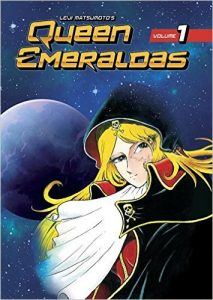By Leiji Matsumoto. Released in Japan by Kodansha, serialized in the magazine Weekly Shonen Magazine. Released in North America by Kodansha Comics. Translated by Zack Davisson.
Sometimes you don’t read a manga for its plot, or characters, or artwork. Sometimes you read a manga because of its mood. You need something that’s evocative, that’s lyrical, that takes you into a different headspace – that of pirate ships in space, and betrayal and heartache, and the repeated narration of a gorgeous scar-faced woman who seems to know she’s speaking to the reader. If you need this, I have good news for you, as Queen Emeraldas is all this and more, and it’s in an omnibus hardcover edition to book, with expensive paper stock. Of course, don’t just get it as a collector’s item. Get it because it’s Leiji Matsumoto at the height of his powers.
The Japanese audience, of course, is familiar with Emeraldas by the time this manga first appeared in the late 1970s. Matsumoto had carved out worlds for everyone – Galaxy Express 999, Space Battleship Yamoto, Captain Harlock – and she was part of the extended cast that flit through these worlds. Let’s just say if she reminds you of Maetel, that’s not an accident. No worries about being lost here, though, as this is her own self-contained title, where she plays a mentor role to a young, driven boy – Hiroshi Umino – who wants to build his own spaceship and go to space. These aren’t just hollow words, either. He does so twice during the course of this volume, though his drive is perhaps somewhat better than his spaceship-building capability. He keeps running into Emeraldas, who stops what she’s doing to prevent him getting killed by the many people and creatures that try to stop him. And along the way, we even get a bit of her own backstory.
Harlock was once rewritten to fit in with Wagner’s Ring Cycle, and reading this it’s not surprising that the two would intermesh – this is not so much a story as it is high opera, with Emeraldas functioning both as the title character and as the chorus. The manga definitely feels like a weekly title, and unlike similar titles the narrative makes no effort to smooth out the constant repetition of who Emeraldas is and why she travels the stars. But she’s not the only one. Characters expound upon their hopes and dreams, and except for Hiroshi, these dreams are mostly shattered or abandoned for various reasons. But their stories also serve to inspire and educate. There’s also some bad guys as well, and the manga does not shirk on the violence – one spoiled rich daughter who tries to have Hiroshi murdered is shot by a firing squad organized by her own father.
There’s not much ongoing plot to follow here, and the characters are mostly static throughout the book. You don’t care, though, because the book is thrilling, and moody, and shows you how cold and vast space really is, and how this can make many people as cool as Emeraldas is. It’s not so much a manga as it is a song. But you’ll want to listen to it again and again.


This is a beautifully-written recommendation! I wasn’t sure whether to pick this one up or not, but now I know I will.